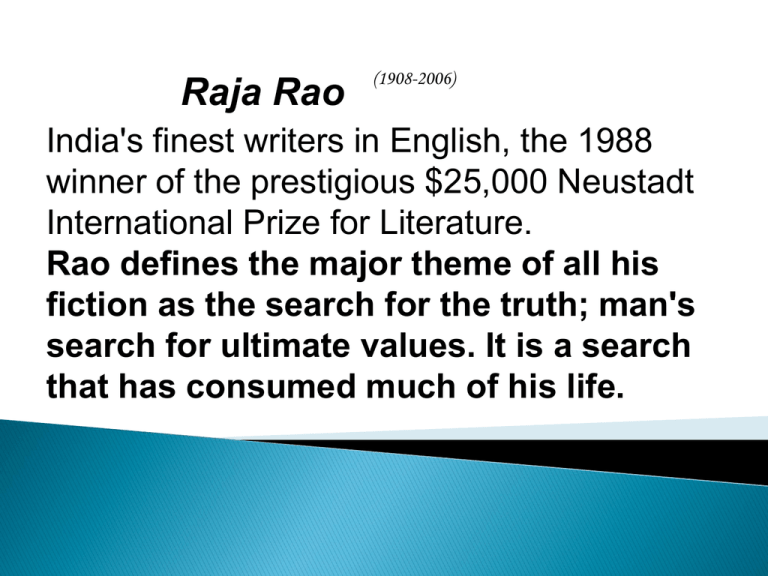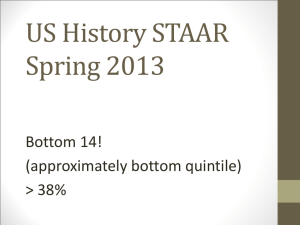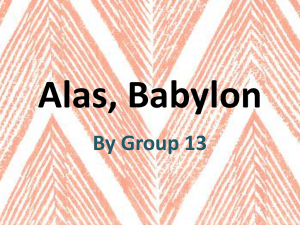Raja Rao
advertisement

Raja Rao (1908-2006) India's finest writers in English, the 1988 winner of the prestigious $25,000 Neustadt International Prize for Literature. Rao defines the major theme of all his fiction as the search for the truth; man's search for ultimate values. It is a search that has consumed much of his life. Rao grew up in Mysore, an area of coffee plantations and famous old temples, in the south of India. He was a member of an old and respected Brahmin family. He did not study fiction writing, but came to it naturally. "I wrote as a man of sixteen or seventeen," Rao says. "I wrote in English. I was sent to a very snobbish English school. I learned English from English people in India. I learned Sanskrit much later." His father was a scholar and professor. But it was from his grandfather, who spoke not a word of English and meditated at length, that Rao got his philosophical bent. "My grandfather started me on the search," he says. "Philosophical inquiry is personal contact. Not merely philosophical thinking. Indian philosophy is thought in the West to be mystical. But it's really logic. Logical and metaphysical." He went to the Aligarh Muslim University and to Nizam's College, Hyderabad, in India. At the age of nineteen, he went to France, where he studied at the University of Montpellier and later at the Sorbonne. He left France in 1939, fifteen days before the outbreak of World War II. "If I'd been there fifteen days more, I'd not be alive today," he says, because of his opposition to Hitler. "I was just lucky. When I got to India, I went straight to a sage." France, to my mind, is still the heart of Western civilization," Rao says. His first wife was a professor of French, and for about thirty years he lived six months in France; six months in India. For a time he considered becoming a monk. His first novel, Kanthapura, about a village in South India affected by the spirit of Gandhi, was published in the United States in 1938. The Serpent and the Rope was published in 1960. Other works include a collection of stories written earlier, The Cow of the Barricades, but published in 1947; The Cat and Shakespeare in 1965; Comrade Kirillov in 1976; The Chessmaster and His Moves in 1988. In the years since, Rao had been working on a sequel to this last novel, which has Indian Vedantic philosophy at its core. In the '60s and '70s the search for values was very remarkable. I was really thinking America would be the greatest nation..." Rao points out that America had been fascinated by India even earlier. "The 19th century transcendentalists--Thoreau, Whitman, Emerson--were all influenced by India. The pragmatic American, I think, has not got time for India." The novel Kanthapura is set against the backdrop of a southern Indian village in the 1930’s where the villagers are content and dependent in their own homogenous culture and tradition. The novel is a long oral tale narrated by Achakka, an old Brahmin grandmother of the village. Into this sociocultural life of set rituals comes a firebrand Gandhian, the educated and radical Moorthy .The novel relates the villagers involvement with the Indian freedom movement and an extremely lifelike presentation of the Gandhian struggle for independence from British colonial rule. Raja Rao merges the myth ridden beliefs of the villagers with that of rational explanations of Moorthy, who as the central character is highly pragmatic yet deeply traditional. “There is no village in India, however mean, that has not a rich sthala-purana, or legendary history of its own. Some god or godlike hero has passed by the village—Rama might have rested under this peepal treee. Sita might have dried her clothes, after her bath, on this yellow stone, or the Mahatma himself, on one of his many pilgrimages through the country, might have slept in this hut, the low one, by the village gate. .”In this way the past mingles with the present, and the Gods mingle with men to make the repertory of your grandmother always bright. One such story from the contemporary annals of my village I have tried to tell.” “The telling has not been easy. One has to convey in a language that is not ones own the spirit that is ones own. One has to convey the various shades and omissions of a certain thought- movement that looks maltreated in an alien language. I use the word ‘alien’, yet English is not really an alien language to us. It is the language of our intellectual make-up- like Sanskrit or Persian was before---but not our emotional makeup. We are all ‘instinctively’ bilingual” "We cannot write like the English. We should not. We cannot write only as Indians. We have to look at the large world as part of us. The tempo of Indian life must be infused into our English expression. We, in India, think quickly, we talk quickly, and when we move we move quickly. There must be something in the sun of India. And our paths are paths interminable I was to write... my English, yet English after all-and how soon we forget this--is an Indo-Aryan tongue. Thus to stretch the English idiom to suit my needs seemed heroic enough for my urgentmost demands. ... So why not Sanskritic (or if you will, Indian) English? ...to integrate the Sanskrit tradition with contemporary intellectual heroism seemed a noble experiment to undertake. Thus both in terms of language and of structure, I had to find my way, whatever the results. And I continued the adventure in lone desperation. When I published my first stories in Europe... Romain Rolland and Stefan Zweig wrote enthusiastic letters to me about them. And Kanthapura, my first novel, was mostly written in a thirteenth-century castle of the Dauphine in the heart of the Alps, and when it came out, E.M. Forster spoke so boldly of my rigour of style and structure, I had, so to say, entered the literary world." The most suggestive and loaded metaphor indeed to critics of Indian English was Caliban’s tongue. It symbolized how Caliban had acquired a voice and used it as a linguistic weapon. “But not for Rao.There is no Caliban here, nor is Rao using English from the periphery. He brings English, and its functions, to the centre of his creativity, to the centre of Indianness.In his hands the crossover of the language is on Rao’s terms”(Kachru 78) Indian Method of Story-telling: The method of describing of the novel is characteristically Indian. The Indian grandmother can be considered to be the earliest and most typical of story tellers. Achkka is the storyteller of the novel, who is just like a grandmother. She tells the story to every new comer to Kanthapura. According to Raja Rao, “Achakka’s exceedingly long sentences, use of blanks, and expressions like ‘this’ and ‘that’, ‘here and there’ are meaningful. She gives us complete character-sketch of Sankar, Bhatt and Rangamma. They are very much informative, as well as vital for the narrative. In this way, one episode leads to another, and so the tale tends to be interminably long. This also makes the narration episodic. There are so many episodes in the novel. Thus, the narration is characterized by verbosity and garrulity, which are the features of the Indian folklore. Raja Rao wanted to stress this admired tradition. As a result he didn’t feel it necessary to divide the novel into chapters. In his Foreword to Kanthapura Raja Rao clarifies that the novel is to be judged with reference to the conventional Indian tradition and not with reference to Western methods of story-telling and theories and of the novel writing. begins with The breathless narration by the garrulous Achakka, playing many roles, recalling the orality of past traditions: “Our village---I don’t think you have ever heard about it---Kanthapura is its name, and it is in the province of Kara. High on the ghats is it, high up the steep mountains that face the cool Arabian Seas, up the Malabar coast is it, up Mangalore and Puttur and many a center of cardomom and coffee, rice and sugarcane”(Rao 1). It is Achakka who goes on to show how the village is presided over by the overpowering legend of Goddess Kenchamma: “Kenchemma is our goddess. Great and bounteous is she. She killed a demon ages, ages ago, a demon that had come tom demand our son’s as food.”’(Rao 1-2) The protagonist Moorthy is introduced by the narrator Achakka in familiar terms: “Cornerhouse Narsamma’s son Moorthy-our Moorthy as we always called him”(Rao 7). To describe with consummate skill a character as “paradoxical as Moorthy and a theme as complex” (Sankaran 43) with its intricate mingling of the mythic and the rational, required great skill in narrative strategy. Moorthy offers a vision of reconstruction and of integration of the possibilities and impossibilities of the philosophic whole, where even intense inward questionings betrayed no jarring collusion or confrontation. The culmination of the conversion of Moorthy is Saint Sankaracharya’s chant: “ …and closing his eyes tighter, he slips back into the foldless sheath of the Soul…and sends out rays of love to the east, rays of love to the west,…. And when he opens them to look around, a great blue radiance seems to fill the whole earth, and dazzled, he rises up and falls prostrate before the god, chanting Sankara’s ‘Sivoham, Sivoham, I am Siva.I am Siva.Siva am I.’ ”(Rao 67). This variability in interpretation integrates certain terms such as taste or essence (rasa) and sound (dhvani-), which reconcile theories of linguistic expressionism with emotional nuances. “What Rao’s mantra did was to create what has been called “unselfconsciousness’ about English, about creativity in this language, about Indianness”(Kachru 82), where “English is ritually de-anglicized”(Parthasarathy 13). The detailed descriptions, sobriquets and labels of persons, as for eg. “Waterfall Venkamma”(Rao 16), “Maddur Coffee planter Venkatanarayana”(Rao 37), “pock marked Sidda”(Rao 5), and of local sights- “Now when you turned round the potters’ Street and walked across the Temple square, the first house you saw was the nine beamed house of Patel Range Gowda”(Rao 60), combined with the abiding presence of the great river Himavathy: “The slow–moving carts begin to grind and to rumble, and then the long harsh monotony of the carts’ axles through the darkness.the noise suddenly dies into the night and the soft hiss of the Himavathy rises in the air” (Rao 1). The reversal of the sentences, the flavour and nuance of the long sentences joined by idioms and expressions, as in the dialect of spoken Kannada of South India simulates the suggestive word, implying suggestive meaning and the power of suggestion. “In Vaisakh men plough the fields of Kanthapura.The rains have come, the fine, first footing-footing rains that skip over the bronze mountains, tiptoe the crags, and leaping into the valleys, go splashing and wind-swung, a winnowed pour, and the coconuts and the betel-nuts and the cardomom plants choke with it and hiss back”(Rao114). Reading this parable like tale is a recollection and recreation of “not only myth but ‘social transactions’ rendered authentic in terms of art by the villagers patois, their sing song syntax…”(Narasimhaiah 54). Whereas the story here as such is involved in arrangement and sequence of juxtaposition, whose endless play of meanings against the visual and graphic is constantly breaking itself off, with the repetitions of images and metaphors, in a design which is often a flow of words, a perspective of the whole order. With the passing years since Kanthapura was first written “we see that Rao’s mantra established a subtle connection between the English language and India’s linguistic and cultural parampara and its assimilative literary culture” (Kachru 81). In infusing his language with a distinctive Indian idiom, Rao maneuvered and moulded the figurative and the literal, making schematic distinctions fade, combining and interacting between the various sound patterning to enunciate a different kind of essence, the soul of Indian poetics, of rasa-dhvani, a completeness of response in an all aesthetic experience. Indian philosophy is basically religious and even politics is also spiritualized in India. India’s so many prominent social reformers and political leaders were great religious figures. In India, communal and political goals have been attained with the help of spiritual activities. The same thing happens in the novel, in the case of Gandhi and his freedom struggle. According to a Narsimhaiah, “there are at least three strands of experience in the novel: the political, the religious and the social.” To the uneducated villagers, Kenchamma is a kind and helpful goddess. Their attitude is extremely religious. As the story progresses the three threads of experience become one: the religious, social and political issues become one and the same. Theme of Shakti Worship: Shakti-worship is a basically Indian theme and it is present throughout the novel. In this Gandhian freedom struggle, the ladies of the Kanthapura play a key role. The author has painted them as energetic forms of Shakti. It can be said that Indian women are solid as rock, and they can easily bear the pain. Shakti(energy) rises in them, and each of them is inspired at a particular time. One noticeable thing in the novel is that in the last phase of nonviolent struggle, it is a lady named Ratna, who takes over from Moorthy and leads the movement. The language of the novel is flooded with the Indian phrases, Indian similes and rustic color. You can find so many sentences in the novel that are exactly translated from Kannada into English. Sometimes, there is breaking up of the English syntax to express emotional disturbances and feelings. Many words are taken from local Indian languages. The author has used them ‘as they are’. He didn’t feel it necessary to translate them into English . In the novel, you can get words likeAhimsa, Dhoti, Harikatha, Mandap etc. Raja Rao has repeatedly used village proverbs, and folklores according to his requirement. For example, (1) Every squirrel has his day, (2) our hearts beat like the wings of bats, (3) and yet he was as honest as an elephant, Likewise, you can found so many proverbs and sayings from the language of illiterate people in the novel. For example: (1) The policemen are not your uncle’s sons, (2) the first daughter milks the cow when the mother is ill, (3) saw you like a rat on your mother’s lap, (4) there is neither man nor mosquito in Kanthapura (5) you cannot straighten a dog’s tail, (6) land, lust and wifely loyalty go badly together. Sometimes Raja Rao doesn’t hesitate to use a rude and offensive language of the villagers. He uses this type of language when it is necessary “When a non native English writer, such as Rao, chooses this specific genre rather than one that is traditional to his own culture, the epic, for instance, and further chooses this genre in a second language, he takes upon himself the burden of synthesizing the projections of both cultures. Out of these circumstances, Rao has forged what I consider a truly exemplary style in South Asian English.in fact in World Literature.He has above all.tried to show how the spirit of one culture can be possessed by and communicated in another language.”(Parthasarathy 9) “I am a man of silence. And words emerge from that silence with light, of light, and light is sacred. One wonders that there is the word at all—sabda-and one asks oneself, where did it come from? How does it arise?…. The word seems to come first as an impulsion from nowhere, and then as a prehension, and it becomes less and less esoteric-till it begins to be concrete… The writer or the poet is he who seeks back the common word to its origin of silence, that the manifested word becomes light…where does the word dissolve and become meaning? Meaning itself, of course, is beyond the sound of the word, which comes to one only as an image in the brain, but that which sees the image in the brain (says our great sage of the eight century, Sri Sankara) nobody has ever seen. Thus the word coming of light is seen eventually by light…”(Paranjape ed.xxv)











